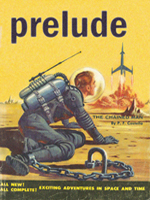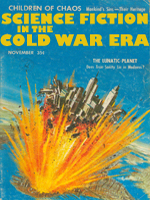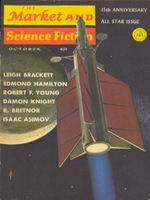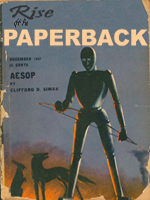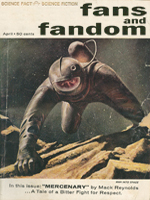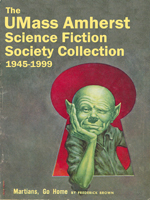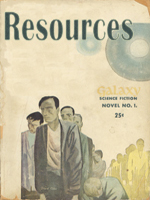The social dynamics of science fiction's hard core of readers were rooted in an earlier age, but fandom really took off in the 1950s. Science fiction fans were like no other group of readers.

Source: UMassSFS collection, Special Collections and University Archives. Photograph: Morgan Hubbard.
From the late 1920s devotees of the genre had sought each other out to talk about science fiction. Fan groups produced what came to be known as "fanzines," a broad category for a diverse group of publications. Fanzines compiled fan commentary on published science fiction, gossip about authors and the fan community (fandom, as it came to be called), and fan-generated fiction and art.
Many science fiction authors started as fans and later turned pro, blurring the lines between producers and consumers. Authors read the reader comments published in the pages of science fiction magazines. Fans organized conventions (cons in fanspeak) at which readers and authors mingled. These fan activities did much to expand science fiction's popularity, both by inducting interested readers and by publicizing the genre's existence.

Photograph courtesy of UMSFS.
Another aspect of fandom is important, though it has less to do with popularizing science fiction. Since the early magazine days, American science fiction had engendered an intensely reciprocal relationship between editors, authors, and fans. The prolific British science fiction novelist John Brunner was guest of honor at the 1983 World Science Fiction Convention (the body that, among other things, selects Hugo Award winners). He told his assembled audience, "Most writers have to depend on the response of their publishers, their editors, a handful of reviewers, and a select circle of personal friends; a science fiction writer, on the other hand, can rely on walking into a convention hotel and meeting dozens of total strangers who have read his or her work and are...willing to offer constructive and informed criticism, often because they are specialists in their field[s]...."
.
A. Joseph Ross founded the UMass-Amherst Science Fiction Society in 1964. In the first decade of its existence the society hosted talks by numerous important figures in the world of science fiction, including Isaac Asimov, Frederik Pohl, and legendary publisher and editor John W. Campbell. UMSFS members also attended conventions, published a fanzine, and opened a science fiction library on campus.
In August 2010 I conducted an oral history with Mr. Ross. Our conversation touched on cons, the growth of science fiction's respectability, and the uneasy place of real-world politics in fandom. Click the link below to play.
Isaac Asimov was invited to the UMass Amherst campus on October 16, 1972, as part of the University's Distinguished Vistor's Program.
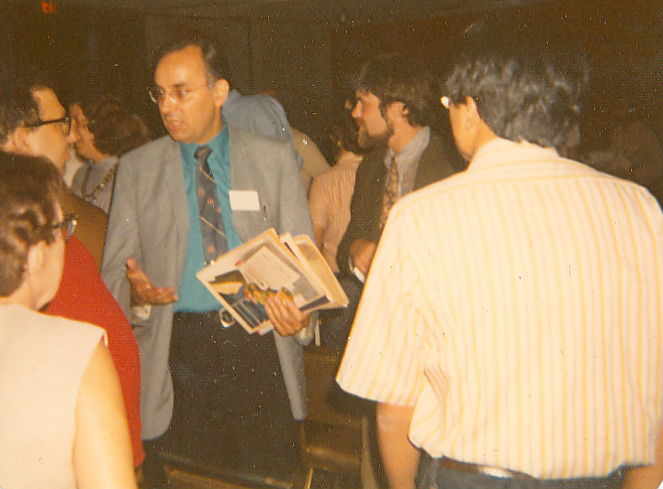
Photograph courtesy of UMSFS.
But what else can we say about science fiction readers in the early cold war years? What were their genders, their ages, their occupations? What were their hobbies? Were they married? Good demographic data on science fiction readers in the early cold war years is scarce, but there are some tantalizing examples. Astounding Science Fiction (ASF) conducted three brief surveys of its readership before 1959. The Magazine of Fantasy and Science Fiction (F&SF), another heavyweight title, conducted a lengthier survey in late 1965 that offers surprising conclusions. Perhaps most important, fan Sam Moskowitz seized the opportunity of the 14th WorldCon (World Science Fiction Convention) to conduct a thorough market survey, using the Con's attendees as his sample.

Photograph: Morgan Hubbard.
None of these surveys were standardized, and they are all from different years. Drawing conclusions means extrapolating from a limited data set. Nevertheless, the portrait of science fiction's overall cold war audience that emerges is worth the risk of misrepresenting individual readers. The surveys paint a picture of science fiction as a genre with broad appeal, a genre suited to mirror the assorted interests and anxieties of the reading public.
Taken together, the surveys show a few things that challenge prevailing assumptions about science fiction's readership. Science fiction was more popular with women than we are given to understand. Its readers worked a far wider range of jobs and pursued many more diverse hobbies than is commonly remembered. And science fiction was never just kids' stuff from its earliest days, it was popular across age categories.
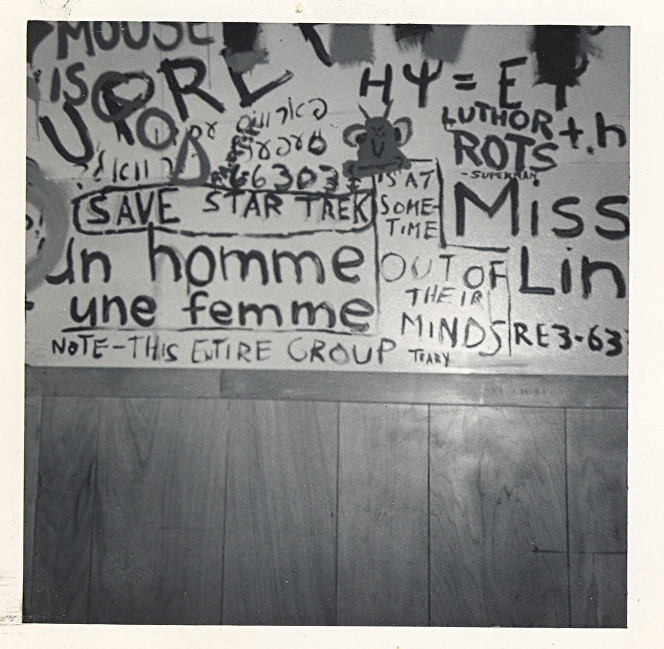
Photograph courtesy of UMSFS.
We can start with the facts that were true of almost all science fiction readers. According to the Moskowitz survey, only 35% made their living in fields related to science. This is surprising; the prevailing stereotype holds that science fiction was for scientists and amateur science enthusiasts of the original Hugo Gernsback mold. In fact, the majority of science fiction readers seemed to work jobs that had little to do with science. The results of the F&SF survey are instructive. Some respondents to that survey reported careers in engineering or the physical sciences, but a great many more worked as everything from housewives and teachers to secretaries and attorneys. One was a professional bowler.
This is not to argue that science fiction did not appeal to men in the hard sciences. Quite the contrary: in every survey, significant minorities of respondents were scientists of one stripe or another. But above these individual data points, the overall trend is surprising: science fiction readers worked in a plethora of fields. This fact speaks to the salience of the genre's basic ideas in the anxious cultural climate of the early cold war years.
The average age of science fiction readers is equally unexpected. According to the Moskowitz study, fully three-quarters of respondents were over the age of 21. Numbers from F&SF from nearly a decade later bear this out: nearly 80% of that magazine's readers were older than 18. At ASF, fewer than seven percent of readers were under age 18. These data have serious implications for how we think about science fiction in the context of the cold war. Clearly, science fiction was not a juvenile genre. It might have been so a generation earlier. But by the late forties and through the fifties, it was middle-aged.
Where gender was concerned, ASF discovered that its readers lined up with the notion of a male-dominated audience. In 1958, 88% of people reading that magazine were men. But F&SF bucked the stereotype, at least by the mid-1960s. In 1965, more than a third (33.5%) were female. That ratio was higher among certain age brackets of F&SF readers: between the ages of 30 and 45, nearly 40% were female. Amazingly, the Moskowtiz market survey -- exhaustive in almost every way -- did not separate respondents by sex. Without a third data point to moderate, these two sets of figures present a perplexing problem. How can we account for this? It's possible that the overall proportions of men and women reading science fiction shifted between 1958 and 1965. But we might also suspect that the nature of the magazines had something to do with it, since Astounding Science Fiction was generally harder fare than that found in the Magazine of Fantasy and Science Fiction. In any case, it's evident that the world of science fiction in print was substantial enough to accommodate different audiences with differing tastes.
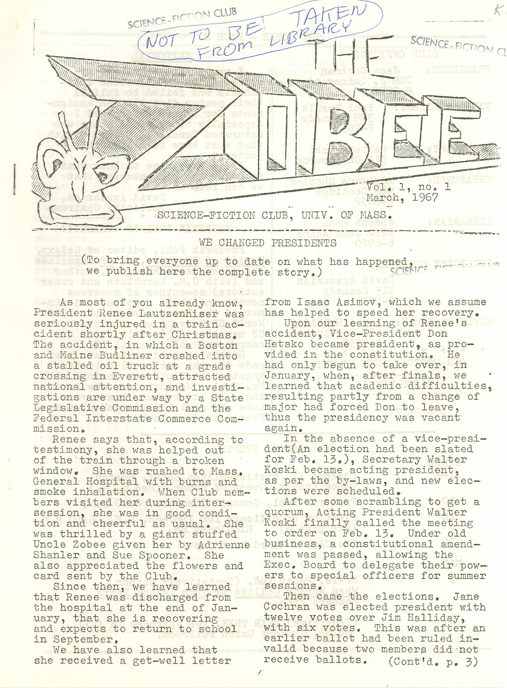
Courtesy of UMSFS.
Taken together, these data suggest a few things. First, as many of science fiction's core ideas (space travel, apocalyptic scenarios) became real possibilities, the genre appeared to gain a measure of legitimacy--and with legitimacy came more readers.
In an essay on fandom, Juanita Carlson remembers:
In 1945, I was twelve. That August, I was buttonholed by relatives and ordered to explain what 'this A-bomb thing is all about.' These same people had previously snickered at my fondness for 'that crazy Buck Rogers stuff.' Now they were treating me like an expert!
No doubt scenes like this played out in homes all over the country. Through about 1960 the American popular consciousness was dogged by a pack of anxieties-about nuclear technology, about war with the Soviet Union, about communist subversion from within America's own borders, and a host of derivative fears. Americans were worried about the future and man's place in it. As the genre that dealt with these concepts most enthusiastically, science fiction was an obvious place American readers could go to try to come to grips with their reality.



